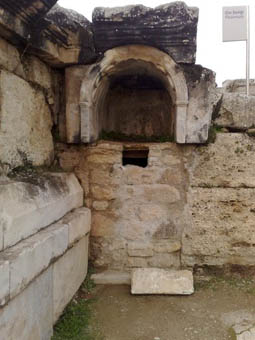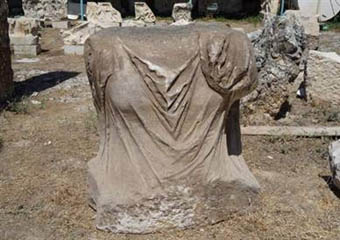The Goddess Apollo?
When St John the Devine wrote short messages to seven churches in the Roman Province of Asia, he probably had no idea of the furore he was setting off. The messages form the introduction to the Book of Revelation, the last book of the Bible which contains a series of horrifying apocalyptic visions that many Christians believe foretell the end of the world and its destruction by fire.
The seven churches are listed in the order followed by the Roman governor as he travelled round his judicial circuit, and as we know that capital cases were reserved for the governor's judgement and that St John was writing at a time of persecution, it is not unreasonable to see these messages as words of encouragement to churches that would shortly be faced with the full severity of Roman law. Martyrdoms by fire, sword or the lions were the common fate of Christians in those early days and John's messages of hope and encouragement - or, alternatively, warnings against backsliding and complacency - were sorely needed.
Centuries later, with the times of persecution nothing but a distant, though revered, memory and the churches themselves deserted and forgotten, some Bible expositors interpreted the messages are predictions of the future, though such attempts usually involved barely honest juggling with history and unexplained leaps between predictions thought to refer to the true people of God and others thought to refer to fallen and corrupt Christianity. Nevertheless these interpretations did serve to maintain interest in the seven churches of Revelation and foster a steady tourist trade as Christian pilgrims visited the ruins of once prosperous cities.
Ephesus, the first of the churches, has substantial ruins, including the remains of two churches and a baptistry, and is well worth a visit. Smyrna has only a Greek agora and no churches. Pergamon has impressive ruins on the acropolis and the fascinating Asculapion with its hints of secret rites. Thyatira has very little to be seen and Sardis is almost as bare, though the tiny Christian church built in the shadow of the massive pagan temple is a most evocative site. Philadelphia has only the remains of a modern church that fell into disrepair after the Christians in town "went away".
The last of the seven, Laodicea, is possibly the least interesting - though the most interesting from the cynic's point of view. The actual remains of Laodicea consist of a substantial tel on which a minimum of archaeological work has been done. It is possible to discern the sunken outline of the hippodrome on one side and the crumbling seats of a theatre cut into the hillside can be seen on the other side. Apart from a few unexplained bits of masonry, that is all, but few pilgrims are disappointed for the simple reason that they never see the place!
Instead they are taken by the bus-load to the nearby site of Hierapolis with its amazing thermal springs and white terraces. The Roman city has been extensively excavated and there is a small but well-stocked museum on the site. As the bus approaches the tour guide reads from the message to the Laodiceans about lukewarm water and then the squealing pilgrims are decanted to hurry into their trunks and bikinis and loll in the bright sunshine and lukewarm water - and it never occurs to them to question whether they are actually in Laodicea or not!
In fact, they are so taken up with disporting themselves in the warm pools that few wander around the ruins, though if they could tear themselves away they would find plenty of interest. Perhaps the most fascinating part is the great temple of Apollo, not so much for the temple - which is a pretty standard Greek-style temple - but for the blocked-up doorway in the platform on which the temple stands. This, believe it or not, is a genuine entrance to the underworld and it is blocked up for the very good reason that anyone who enters it, dies.

|
| The entrance to the Plutonium. When I saw it the doorway was blocked with rusty chicken wire which clearly proved inadequate and has since been replaced with a stone wall. |
Known as the Plutonium and described in detail by Strabo, Cassius Dio, Damascius and several other writers, the doorway gives onto a natural fissure through which flows a fast-moving stream of hot water. From this water rises a nasty-smelling gas, but it is not the smelly gas which is the problem. The same geologic activity that heats the water also releases quantities of carbon-dioxide, which is, of course, a killer.
This geologic activity appears to have been more intense in the past, for the ancient writers describe how the priests sold birds and small animals to pilgrims which were released into the courtyard in front of the Plutonium. Although the courtyard covered 22,000 square feet, it was so filled with the heavier-than-air gas that the creatures released into it fell dead after a few steps or wing beats, thereby proving that the doorway led down to the infernal regions whose noxious exhalations were deadly.
The gas also provided a handy way of sorting out clergy of whom the gods approved from the other kind. Aspirant priests of Cybele who had survived self-castration - so that they considered themselves priestesses - were required to enter the cave. If they survived, they were obviously people to be revered; a more cynical person might suspect that they were simply better at holding their breath!
If you are interested in visiting this fascinating site you can, of course, come on the Diggings tour - just make sure that Turkey and Hierapolis is included in that year's itinerary. A cheaper, though less satisfying, option is to wait for the National Research Council in Lecce, Italy, which is working on a "Virtual Hierapolis" - a quick look at their website suggests that this is simply a set of photographs linked to a map rather than a proper walk-through 3D virtual reality reconstruction of the ancient city.

|
| The torso of the newly discovered statue of Apollo. The drapery appears to conceal an impressive bust. |
The National Research Council is responsible for excavations at Hierapolis and has recently announced the discovery of a colossal statue of Apollo. The press release claims that the figure "emerged from the white cliffs", but as the calcite terraces are a Turkish national heritage site I would think that any archaeologist taking a camel's hair brush to them would be in deep trouble. Only part of the statue has been found, but the archaeologists estimate that when new and complete it was a seated statue thirteen feet high, depicting the god on his throne with a lyre or kithera in his left hand.
The statue must have been placed inside the temple, for the rear is unfinished. Presumably the priests comforted themselves that no worshipper would ever get round the back to see the way they had scamped on artist's fees, but one wonders what All-seeing Apollo made of his priests' parsimony. Pictures released of the torso of the broken statue make me wonder at the archaeologists' identification. The god appears to be wearing a dress and the draperies on his chest barely cover a bust that would more than fill any Wonder-bra. The god appears to me to be more of a goddess, so the discovery of the statue's head - which the archaeologists eagerly anticipate - should be of more than usual interest. Will it have a beard or a smile?
went away I never read those weasel words on the information board inside the church without grinding my teeth in rage. In fact the Christians of Philadelphia were rounded up and deported with the utmost barbarity by the Turkish government during the First World War. Untold thousands of Armenians were starved or tortured to death in a deliberate act of genocide in which the populace were enthusiastic participants. Unlike Germany, which has admitted its guilt over the attempted genocide of the Jews, Turkey steadfastly refuses to acknowledge its guilt. Several Turkish scholars and writers who have attempted to raise the matter have been prosecuted and punished for "bringing the state into disrepute" - an attack on free speech and honesty that does more to bring Turkey into disrepute than anything else.
Until Turkey acknowledges what it did and apologises, it should be regarded as a pariah state - and I say this despite the fact that the Turks are possibly my favourite Middle Eastern people. Return
© Kendall K. Down 2009





